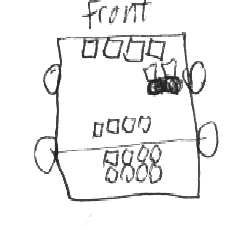Building the battery boxes entails several goals.
1. To secure the heaviest conversion parts, the energy source, the batteries in a way where they are safe from damage and safe from damaging other parts including the passengers.
 Early Battery Location Plans
Early Battery Location Plans
2. Locate them as low as possible so the low center of gravity will help the handling of the now heavier vehicle.
3. Locate them for weight distribution is important. Place the batteries near the heavy frame parts of the vehicle which is usually around the suspension or wheels. It would be nice if I could put most of the batteries in the front of the vehicle but there is not room there so I plan on putting 12 of them behind the rear seat as forward as possible. Heavier rear springs will be required.
4. Seal them from venting into the cabin area.
5. Vent the hydrogen fumes properly.
6. Control the temperature of the batteries. Cool them in the summer and heat them or allow them to build up some heat in the winter. The higher the temperature the faster the chemical action, which is higher capacity or amperage output. Above 80F the plates do deteriorate faster. When the batteries are discharging during driving the electrolyte will increase temperature by 12 degrees F. They also warm up during charging. So the IDEAL TEMPERATURE is around 68F so the batteries have a long life but also have a high capacity.